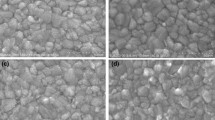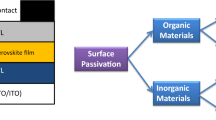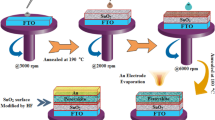Abstract
Herein, additives and interface engineering are used to reduce the defects of perovskite solar cells (PSCs) prepared in ambient air and improve its performance. Specifically, urea is introduced into TiO2 and the perovskite layer, respectively. Both the contact angle and roughness of the TiO2 layer are found to be improved, which is helpful to enhance the quality of the subsequent perovskite layer. In addition, urea is added into the perovskite layer to delay the crystallization process of PbI2 by forming the intermediate products. And the larger grain size and appropriate number of pores are obtained, which lower the crystallization potential energy barrier of the perovskite film during the second-step spin-coating. Interface engineering between the perovskite bottom layer and the TiO2 top layer by PEABr is found that the quasi-2D perovskite is generated at the bottom of the perovskite, and the 2D perovskite could passivate the interface defects of the 3D perovskite. Finally, CsCl is further added to the perovskite, which improves the tolerance factor of the perovskite film. Ultimately, the optimal device exhibits a champion PCE of 18.41%, a nearly 30% improvement compared to the original device, which could facilitate commercialization in ambient air environment.








Similar content being viewed by others
Data availability
All data included in this study are available upon request by contact with the corresponding author.
References
B. Parida, S. Iniyan, R. Goic, A review of solar photovoltaic technologies. Renew. Sustain. Energy Rev. 15(3), 1625–1636 (2011). https://doi.org/10.1016/j.rser.2010.11.032
S.Y. Sun, T. Salim, N. Mathews, M. Duchamp, C. Boothroyd, G.C. Xing, T.C. Sum, Y.M. Lam, The origin of high efficiency in low-temperature solution-processable bilayer organometal halide hybrid solar cells. Energy Environ. Sci. 7(1), 399–407 (2014). https://doi.org/10.1039/c3ee43161d
S. De Wolf, J. Holovsky, S.-J. Moon, P. Loeper, B. Niesen, M. Ledinsky, F.-J. Haug, J.-H. Yum, C. Ballif, Organometallic halide perovskites: sharp optical absorption edge and its relation to photovoltaic performance. J. Phys. Chem. Lett. 5(6), 1035–1039 (2014). https://doi.org/10.1021/jz500279b
J. Burschka, N. Pellet, S.-J. Moon, R. Humphry-Baker, P. Gao, M.K. Nazeeruddin, M. Graetzel, Sequential deposition as a route to high-performance perovskite-sensitized solar cells. Nature 499(7458), 316 (2013). https://doi.org/10.1038/nature12340
T. Niu, J. Lu, R. Munir, J. Li, D. Barrit, X. Zhang, H. Hu, Z. Yang, A. Amassian, K. Zhao, S. Liu, Stable high-performance perovskite solar cells via grain boundary passivation. Adv. Mater. (2018). https://doi.org/10.1002/adma.201706576
G.E. Eperon, S.D. Stranks, C. Menelaou, M.B. Johnston, L.M. Herz, H.J. Snaith, Formamidinium lead trihalide: a broadly tunable perovskite for efficient planar heterojunction solar cells. Energy Environ. Sci. 7(3), 982–988 (2014). https://doi.org/10.1039/c3ee43822h
H. Cho, S.-H. Jeong, M.-H. Park, Y.-H. Kim, C. Wolf, C.-L. Lee, J.H. Heo, A. Sadhanala, N. Myoung, S. Yoo, S.H. Im, R.H. Friend, T.-W. Lee, Overcoming the electroluminescence efficiency limitations of perovskite light-emitting diodes. Science 350(6265), 1222–1225 (2015). https://doi.org/10.1126/science.aad1818
Y. Rong, Y. Hu, A. Mei, H. Tan, M.I. Saidaminov, S.I. Seok, M.D. McGehee, E.H. Sargent, H. Han, Challenges for commercializing perovskite solar cells. Science (2018). https://doi.org/10.1126/science.aat8235
J.H. Noh, S.H. Im, J.H. Heo, T.N. Mandal, S.I. Seok, Chemical management for colorful, efficient, and stable inorganic–organic hybrid nanostructured solar cells. Nano Lett. 13(4), 1764–1769 (2013). https://doi.org/10.1021/nl400349b
Y.-C. Wang, J. Chang, L. Zhu, X. Li, C. Song, J. Fang, Electron-transport-layer-assisted crystallization of perovskite films for high-efficiency planar heterojunction solar cells. Adv. Funct. Mater. (2018). https://doi.org/10.1002/adfm.201706317
M.M. Lee, J. Teuscher, T. Miyasaka, T.N. Murakami, H.J. Snaith, Efficient hybrid solar cells based on meso-superstructured organometal halide perovskites. Science 338(6107), 643–647 (2012). https://doi.org/10.1126/science.1228604
M. Kim, J. Jeong, H. Lu, T.K. Lee, F.T. Eickemeyer, Y. Liu, I.W. Choi, S.J. Choi, Y. Jo, H.-B. Kim, S.-I. Mo, Y.-K. Kim, H. Lee, N.G. An, S. Cho, W.R. Tress, S.M. Zakeeruddin, A. Hagfeldt, J.Y. Kim, M. Gratzel, D.S. Kim, Conformal quantum dot-SnO2 layers as electron transporters for efficient perovskite solar cells. Science 375(6578), 302 (2022). https://doi.org/10.1126/science.abh1885
T. Zhong, L. Shi, H. Hao, J. Dong, K. Tang, X. Xu, S.L. Hamukwaya, H. Liu, J. Xing, Simple method of dual passivation with efficiency beyond 20% for fabricating perovskite solar cells in the full ambient air. ACS Sustain. Chem. Eng. 9(38), 13010–13020 (2021). https://doi.org/10.1021/acssuschemeng.1c04542
Y. Zhang, A. Kirs, F. Ambroz, C.T. Lin, A.S.R. Bati, I.P. Parkin, J.G. Shapter, M. Batmunkh, T.J. Macdonald, Ambient fabrication of organic–inorganic hybrid perovskite solar cells. Small Methods 5(1), 2000744 (2020). https://doi.org/10.1002/smtd.202000744
B. Chen, P.N. Rudd, S. Yang, Y. Yuan, J. Huang, Imperfections and their passivation in halide perovskite solar cells. Chem. Soc. Rev. 48(14), 3842–3867 (2019). https://doi.org/10.1039/c8cs00853a
H. Xie, X. Yin, J. Liu, Y. Guo, P. Chen, W. Que, G. Wang, B. Gao, Low temperature solution-derived TiO2–SnO2 bilayered electron transport layer for high performance perovskite solar cells. Appl. Surf. Sci. 464, 700–707 (2019). https://doi.org/10.1016/j.apsusc.2018.09.146
A.F. Akbulatov, L.A. Frolova, M.P. Griffin, I.R. Gearba, A. Dolocan, D.A. Vanden Bout, S. Tsarev, E.A. Katz, A.F. Shestakov, K.J. Stevenson, P.A. Troshin, Effect of electron-transport material on light-induced degradation of inverted planar junction perovskite solar cells. Adv. Energy Mater. (2017). https://doi.org/10.1002/aenm.201700476
S. Lin, B. Yang, X. Qiu, J. Yan, J. Shi, Y. Yuan, W. Tan, X. Liu, H. Huang, Y. Gao, C. Zhou, Efficient and stable planar hole-transport-material-free perovskite solar cells using low temperature processed SnO2 as electron transport material. Org. Electron. 53, 235–241 (2018). https://doi.org/10.1016/j.orgel.2017.12.002
S. Zheng, G. Wang, T. Liu, L. Lou, S. Xiao, S. Yang, Materials and structures for the electron transport layer of efficient and stable perovskite solar cells. Science China 62(7), 800–809 (2019). https://doi.org/10.1007/s11426-019-9469-1
H. Sun, D. Xie, Z. Song, C. Liang, L. Xu, X. Qu, Y. Yao, D. Li, H. Zhai, K. Zheng, C. Cui, Y. Zhao, Interface defects passivation and conductivity improvement in planar perovskite solar cells using Na2S-doped compact TiO2 electron transport layers. ACS Appl. Mater. Interfaces 12(20), 22853–22861 (2020). https://doi.org/10.1021/acsami.0c03180
H. Kim, J. Hong, C. Kim, E.-Y. Shin, M. Lee, Y.-Y. Noh, B. Park, I. Hwang, Impact of hydroxyl groups boosting heterogeneous nucleation on perovskite grains and photovoltaic performances. J. Phys. Chem. C 122(29), 16630–16638 (2018). https://doi.org/10.1021/acs.jpcc.8b05374
Y. Li, X. Li, Q. Chu, H. Dong, J. Yao, Y. Zhou, G. Yang, Tuning nucleation sites to enable monolayer perovskite films for highly efficient perovskite solar cells. Coatings (2018). https://doi.org/10.3390/coatings8110408
A.A. Petrov, I.P. Sokolova, N.A. Belich, G.S. Peters, P.V. Dorovatovskii, Y.V. Zubavichus, V.N. Khrustalev, A.V. Petrov, M. Graetzel, E.A. Goodilin, A.B. Tarasov, Crystal structure of DMF-intermediate phases uncovers the link between CH3NH3PbI3 morphology and precursor stoichiometry. J. Phys. Chem. C 121(38), 20739–20743 (2017). https://doi.org/10.1021/acs.jpcc.7b08468
B. Liu, S. Wang, Z. Ma, J. Ma, R. Ma, C. Wang, High-performance perovskite solar cells with large grain-size obtained by the synergy of urea and dimethyl sulfoxide. Appl. Surf. Sci. 467, 708–714 (2019). https://doi.org/10.1016/j.apsusc.2018.10.141
L. Han, S. Cong, H. Yang, Y. Lou, H. Wang, J. Huang, J. Zhu, Y. Wu, Q. Chen, B. Zhang, L. Zhang, G. Zou, Environmental-friendly urea additive induced large perovskite grains for high performance inverted solar cells. Solar Rrl (2018). https://doi.org/10.1002/solr.201800054
J. Cao, X. Jing, J. Yan, C. Hu, R. Chen, J. Yin, J. Li, N. Zheng, Identifying the molecular structures of intermediates for optimizing the fabrication of high-quality perovskite films. J. Am. Chem. Soc. 138(31), 9919–9926 (2016). https://doi.org/10.1021/jacs.6b04924
N. Ahn, D.-Y. Son, I.-H. Jang, S.M. Kang, M. Choi, N.-G. Park, Highly reproducible perovskite solar cells with average efficiency of 183% and best efficiency of 197% fabricated via Lewis base adduct of lead(II) iodide. J. Am. Chem. Soc. 137(27), 8696–8699 (2015). https://doi.org/10.1021/jacs.5b04930
S. Yang, J. Dai, Z. Yu, Y. Shao, Y. Zhou, X. Xiao, X.C. Zeng, J. Huang, Tailoring passivation molecular structures for extremely small open-circuit voltage loss in perovskite solar cells. J. Am. Chem. Soc. 141(14), 5781–5787 (2019). https://doi.org/10.1021/jacs.8b13091
H.S. Kim, A. Hagfeldt, N.G. Park, Morphological and compositional progress in halide perovskite solar cells. Chem. Commun. (Camb) 55(9), 1192–1200 (2019). https://doi.org/10.1039/c8cc08653b
E. Aydin, M. De Bastiani, S. De Wolf, Defect and contact passivation for perovskite solar cells. Adv. Mater. 31(25), e1900428 (2019). https://doi.org/10.1002/adma.201900428
W. Zhang, M. Saliba, D.T. Moore, S.K. Pathak, M.T. Horantner, T. Stergiopoulos, S.D. Stranks, G.E. Eperon, J.A. Alexander-Webber, A. Abate, A. Sadhanala, S. Yao, Y. Chen, R.H. Friend, L.A. Estroff, U. Wiesner, H.J. Snaith, Ultrasmooth organic–inorganic perovskite thin-film formation and crystallization for efficient planar heterojunction solar cells. Nat. Commun. 6, 6142 (2015). https://doi.org/10.1038/ncomms7142
N. Awol, C. Amente, G. Verma, J.Y. Kim, Morphology and surface analyses for CH3NH3PbI3 perovskite thin films treated with versatile solvent-antisolvent vapors. RSC Adv. 11(29), 17789–17799 (2021). https://doi.org/10.1039/d1ra02645c
H. Wang, J. Zhang, Methylammonium chloride additive in lead iodide optimizing the crystallization process for efficient perovskite solar cells. Int. J. Photoenergy (2022). https://doi.org/10.1155/2022/5288400
T. Bu, X. Liu, Y. Zhou, J. Yi, X. Huang, L. Luo, J. Xiao, Z. Ku, Y. Peng, F. Huang, Y.-B. Cheng, J. Zhong, A novel quadruple-cation absorber for universal hysteresis elimination for high efficiency and stable perovskite solar cells. Energy Environ. Sci. 10(12), 2509–2515 (2017). https://doi.org/10.1039/c7ee02634j
H. Wang, H. Liu, Z. Dong, T. Song, W. Li, L. Zhu, Y. Bai, H. Chen, Size mismatch induces cation segregation in CsPbI3: forming energy level gradient and 3D/2D heterojunction promotes the efficiency of carbon-based perovskite solar cells to over 15%. Nano Energy 89, 106411 (2021). https://doi.org/10.1016/j.nanoen.2021.106411
L.K. Ono, S.F. Liu, Y. Qi, Reducing detrimental defects for high-performance metal halide perovskite solar cells. Angew. Chem. Int. Ed. Engl. 59(17), 6676–6698 (2020). https://doi.org/10.1002/anie.201905521
P. Scherrer, Bestimmung der Grosse und der inneren Struktur von Kolloidteilchen mittels Rontgenstrahlen. X-ray diffraction methods in polymer science, 1969
J.I. Langford, A.J.C. Wilson, Scherrer after sixty years: a survey and some new results in the determination of crystallite size. J. Appl. Crystallogr. 11(2), 102–113 (1978). https://doi.org/10.1107/S0021889878012844
B.D. Cullity, Elements of X-ray Diffraction (Addison-Wesley, Reading, 1956)
C. Xu, Z. Zhang, Y. Hu, Y. Sheng, P. Jiang, H. Han, J. Zhang, Printed hole-conductor-free mesoscopic perovskite solar cells with excellent long-term stability using PEAI as an additive. J. Energy Chem. 27(3), 764–768 (2018). https://doi.org/10.1016/j.jechem.2018.01.030
J. Li, M. Wu, G. Yang, D. Zhang, Z. Wang, D. Zheng, J. Yu, Bottom-up passivation effects by using 3D/2D mix structure for high performance p-i-n perovskite solar cells. Sol. Energy 205, 44–50 (2020). https://doi.org/10.1016/j.solener.2020.05.042
H. Wang, H. Liu, Z. Dong, X. Wei, Y. Song, W. Li, L. Zhu, Y. Bai, H. Chen, Extracting ammonium halides by solvent from the hybrid perovskites with various dimensions to promote the crystallization of CsPbI3 perovskite. Nano Energy 94, 106925 (2022). https://doi.org/10.1016/j.nanoen.2022.106925
T. Stergiopoulos, S. Karakostas, P. Falaras, Comparative studies of substituted ruthenium(II)-pyrazoyl-pyridine complexes with classical N3 photosensitizer: the influence of -NCS dye ligands on the efficiency of solid-state nanocrystalline solar cells. J. Photochem. Photobiol. A 163(3), 331–340 (2004). https://doi.org/10.1016/j.jphotochem.2004.01.002
X. Liu, Z. Liu, B. Sun, X. Tan, H. Ye, Y. Tu, T. Shi, Z. Tang, G. Liao, 17.46% efficient and highly stable carbon-based planar perovskite solar cells employing Ni-doped rutile TiO2 as electron transport layer. Nano Energy 50, 201–211 (2018). https://doi.org/10.1016/j.nanoen.2018.05.031
Q.A. Akkerman, G. Raino, M.V. Kovalenko, L. Manna, Genesis, challenges and opportunities for colloidal lead halide perovskite nanocrystals. Nat. Mater. 17(5), 394–405 (2018). https://doi.org/10.1038/s41563-018-0018-4
Q. Han, S. Yang, L. Wang, F. Yu, C. Zhang, M. Wu, T. Ma, The sulfur-rich small molecule boosts the efficiency of carbon-based CsPbI2Br perovskite solar cells to approaching 14%. Sol. Energy 216, 351–357 (2021). https://doi.org/10.1016/j.solener.2021.01.030
Z. Zhao, F. Gu, H. Rao, S. Ye, Z. Liu, Z. Bian, C. Huang, Metal halide perovskite materials for solar cells with long-term stability. Adv. Energy Mater. 9(3), 1802671 (2019). https://doi.org/10.1002/aenm.201802671
V.L. Pool, A. Gold-Parker, M.D. McGehee, M.F. Toney, Chlorine in PbCl2-derived hybrid-perovskite solar absorbers. Chem. Mater. 27(21), 7240–7243 (2015). https://doi.org/10.1021/acs.chemmater.5b03581
Acknowledgements
This work is financially supported by the National Natural Science Foundation of China (Grant No. 21875223), and the Open Foundation of Key Laboratory of Semiconductor Materials Science Institute of Semiconductors, Chinese Academy of Sciences (Grant No. KLSMS-1901).
Funding
Funding was provided by National Natural Science Foundation of China (Grant No. 21875223), Open Foundation of Key Laboratory of Semiconductor Materials Science Institute of Semiconductors, Chinese Academy of Sciences (Grant No. KLSMS-1901).
Author information
Authors and Affiliations
Contributions
TZ: investigation, writing original draft, visualization. KT: methodology, carrying out measurements. ST: methodology. WS: project administration. WX: project administration. JD: resources. HL: resources. JX: resources. HH: conceptualization, methodology, writing—review and editing.
Corresponding author
Ethics declarations
Conflict of interest
The authors declare that they have no conflict of interest.
Additional information
Publisher's Note
Springer Nature remains neutral with regard to jurisdictional claims in published maps and institutional affiliations.
Supplementary Information
Below is the link to the electronic supplementary material.
Rights and permissions
Springer Nature or its licensor (e.g. a society or other partner) holds exclusive rights to this article under a publishing agreement with the author(s) or other rightsholder(s); author self-archiving of the accepted manuscript version of this article is solely governed by the terms of such publishing agreement and applicable law.
About this article
Cite this article
Zhong, T., Tang, K., Tang, S. et al. Additives and interface engineering facilitate the fabrication of high-efficiency perovskite solar cells in ambient air-processed. J Mater Sci: Mater Electron 34, 1055 (2023). https://doi.org/10.1007/s10854-023-10417-7
Received:
Accepted:
Published:
DOI: https://doi.org/10.1007/s10854-023-10417-7




